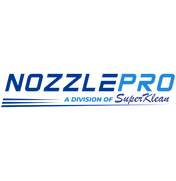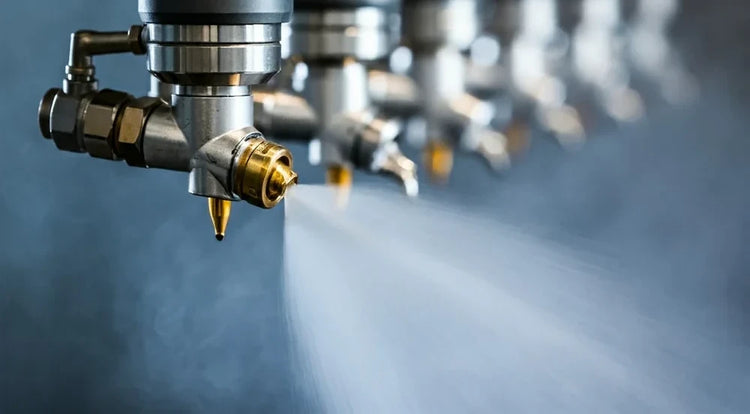Home › Applications › Tank & Vessel Cleaning › Large Tank & Reactor Cleaning
Large Tank & Reactor Cleaning Nozzles
High-Impact Spray Solutions for Industrial Vessels.
Cleaning large tanks and reactors is one of the most demanding challenges in chemical processing, petroleum refining, and wastewater treatment. NozzlePro large tank and reactor cleaning nozzles deliver powerful, high-impact sprays that ensure thorough residue removal, improved hygiene, and optimized process efficiency. Our precision-engineered nozzles reduce cleaning time by up to 75%, minimize water consumption by 45%, and significantly enhance worker safety by reducing manual tank entry requirements.
Designed for fixed or rotary installation, our nozzles provide complete 360° coverage in vessels ranging from 5,000 gallons to over 1 million gallons, while reducing downtime, labor costs, and resource consumption. Whether cleaning reactors with hazardous chemical residues, petroleum storage tanks with crude buildup, or wastewater digesters with heavy sludge, NozzlePro delivers the cleaning power and reliability industrial operations demand.
Why Large Tank Cleaning Demands Specialized Nozzles
Manual cleaning of large industrial tanks poses extreme safety risks including confined space hazards, toxic exposure, and physical injury. Traditional cleaning methods require days of downtime, consume thousands of gallons of water, and produce inconsistent results. NozzlePro rotary jet cleaning systems eliminate 90% of manual tank entry, reduce cleaning cycles from 48+ hours to 4–8 hours, cut water usage by 45%, and provide validated, repeatable cleaning performance. Advanced designs handle tank diameters up to 150 feet with complete wall, ceiling, and floor coverage that manual cleaning cannot match.
Explore Nozzle Types
Critical Applications in Large Tank & Reactor Cleaning
⚗️ Chemical Processing
Remove residues, polymerization buildup, and chemical deposits from reactors, blending vessels, polymerization tanks, and chemical storage facilities (10,000–500,000 gallons). High-impact rotary nozzles operating at 100–200 PSI deliver the force needed to remove stubborn polymer films, crystallized materials, and cross-linked residues that compromise product quality and reactor efficiency. Precision-engineered spray patterns improve process consistency, reduce contamination risks between batches, and extend vessel service life by preventing corrosion and scaling.
🛢 Petroleum & Energy
High-impact rotary jet nozzles clean crude oil storage tanks (up to 1 million+ gallons), reactor vessels, asphalt tanks, and refining units, removing heavy crude deposits, paraffin wax buildup, and sludge accumulation. Automated cleaning systems minimize confined space entry in hazardous ATEX/Class 1 Division 1 environments, reducing safety incidents by 95%. Specialized designs handle high-temperature applications (up to 400°F) for hot oil tanks and maintain performance with highly viscous petroleum products that clog conventional spray systems.
💧 Wastewater Treatment
Tank cleaning nozzles remove sludge, scale, biofilm, and sediment in clarifiers (50–150 feet diameter), anaerobic digesters, settling tanks, and holding basins. Powerful rotary jets operating at 80–150 PSI break up compacted sludge layers up to 3 feet thick, restore tank capacity, and maintain treatment efficiency. Regular automated cleaning reduces manual dredging costs by 70%, prevents odor issues from decomposing organic matter, supports regulatory compliance for suspended solids limits, and extends the time between costly tank decommissioning and deep cleaning operations.
Benefits of NozzlePro Large Tank & Reactor Cleaning Nozzles
Complete 360° Coverage
Rotary jet technology delivers indexed or continuous rotation for thorough cleaning of all tank surfaces including walls, ceilings, and floors.
Reduced Downtime
Automated cleaning cycles complete in 4–8 hours versus 48+ hours for manual cleaning, maximizing production uptime.
Enhanced Safety
Eliminate 90% of confined space entry requirements, reducing worker exposure to toxic atmospheres and physical hazards.
Extreme Durability
316/316L stainless steel, Hastelloy, and ceramic-coated designs withstand corrosive chemicals, abrasive slurries, and high temperatures up to 400°F.
High-Impact Cleaning Power
Operating pressures from 80–250 PSI with flow rates up to 500 GPM remove the toughest residues, scale, and buildup.
Water & Chemical Efficiency
Optimized spray patterns reduce water consumption by 45% and cleaning chemical usage by 40% versus manual methods.
Versatile Installation
Permanent fixed mounting, portable systems, or robotic deployment options for tanks from 5,000 to 1,000,000+ gallons.
Cost Reduction
Lower labor costs by 80%, reduce waste disposal by 50%, and decrease equipment wear from manual cleaning operations.
Industries We Serve
Chemical & Petrochemical
Polymerization reactors, blending vessels, chemical storage tanks, reactor units, monomer storage, polymer processing vessels, and specialty chemical manufacturing requiring thorough residue removal and cross-contamination prevention.
Petroleum & Energy
Crude oil storage tanks, refining vessels, asphalt tanks, heavy oil storage, paraffin wax tanks, bitumen storage, and petrochemical intermediates requiring high-impact cleaning in hazardous classified areas.
Wastewater Treatment
Clarifiers, digesters, settling basins, equalization tanks, sludge holding tanks, aerobic and anaerobic digesters, and industrial wastewater treatment systems maintaining capacity and regulatory compliance.
Pulp & Paper
Black liquor tanks, pulp digesters, white liquor storage, chemical recovery systems, and papermaking process vessels removing lignin, fiber, and chemical deposits.
Mining & Minerals
Leach tanks, thickeners, flotation cells, pregnant and barren solution tanks, heap leach ponds, and mineral processing vessels removing scale, precipitates, and slimes.
Power Generation
Cooling towers, condensate storage, fuel oil tanks, ash slurry tanks, FGD systems, and power plant process vessels maintaining efficiency and preventing corrosion.
Recommended Nozzle Configurations for Large Tanks
| Tank Size / Application | Recommended Nozzle | Key Advantages | Shop |
|---|---|---|---|
| Medium Vessels (5K–20K gal) | Rotary Jet Heads (Low-Flow) | 360° coverage, moderate impact force, suitable for process vessels and small storage tanks | Hollow Cone |
| Large Tanks (20K–100K gal) | High-Impact Rotary Nozzles | Powerful cleaning jets, 50–150 GPM flow rates, removes heavy deposits and scale buildup | Hollow Cone |
| Very Large Tanks (100K–1M+ gal) | Industrial Rotary Tank Cleaners | Maximum throw distance (up to 75 feet), 100–500 GPM, designed for petroleum and large storage vessels | Hollow Cone |
| Light Soil / Rinsing | Full Cone Static Nozzles | Cost-effective for final rinse cycles, removing loose particles and light residues in large tanks | Full Cone |
| All Large Tank Systems | High-Pressure Hoses, Filters, Fittings | Support high-flow systems, prevent debris damage, enable flexible installation and maintenance | Accessories |
Not sure which cleaning system is right for your large tank or reactor? Our industrial tank cleaning specialists will evaluate your vessel dimensions, residue types, cleaning objectives, and safety requirements to recommend the optimal automated cleaning solution. Request a free tank assessment including spray coverage simulation and ROI analysis.
Why Choose NozzlePro for Large Tank & Reactor Cleaning?
NozzlePro provides engineered spray systems for large tank and reactor cleaning that deliver high-impact, reliable performance in the most demanding industrial environments. Whether you operate in chemical processing, petroleum refining, or wastewater treatment, our automated tank cleaning nozzles help you achieve thorough residue removal, improved worker safety, and greater process efficiency. With proven installations in tanks up to 150 feet diameter, chemical-resistant materials rated for extreme conditions, comprehensive engineering support including CFD spray modeling, and rapid ROI through reduced labor and downtime, NozzlePro is the trusted partner for industrial tank cleaning solutions worldwide.
Large Tank Cleaning Performance Specifications
Operating Pressure: 80–250 PSI (5.5–17 bar) for large vessel applications
Flow Rates: 20–500 GPM (75–1,900 LPM) depending on tank size and soil conditions
Materials: 316/316L stainless steel, Hastelloy C-276, duplex stainless, ceramic-coated for abrasion resistance
Throw Distance: 15–75 feet radius coverage depending on pressure and nozzle design
Rotation Speed: 0.5–8 RPM (indexed or continuous) for optimized cleaning cycles
Temperature Rating: Standard to 250°F (121°C), high-temp designs to 400°F (204°C)
Tank Capacity Range: 5,000 gallons to 1,000,000+ gallons
Cleaning Cycle Time: 4–12 hours typical for automated systems vs. 48+ hours manual
Hazardous Area Ratings: ATEX certified, Class I Division 1 designs available
Helpful Resources
Explore related product categories and technical support:
Large Tank & Reactor Cleaning FAQs
What size tanks can rotary jet cleaners handle?
Rotary jet tank cleaning nozzles effectively clean vessels from 5,000 gallons to over 1 million gallons. Small rotary jets handle tanks up to 20 feet diameter, mid-range units clean tanks 20–50 feet diameter, and high-powered industrial cleaners with 50–200 GPM flow rates handle massive storage tanks up to 150 feet diameter. Proper nozzle selection depends on tank dimensions, residue type, and available water pressure/flow.
How much pressure and flow are needed for large tank cleaning?
Large tank cleaning typically requires 100–200 PSI for effective residue removal. Small to medium tanks (5,000–50,000 gallons) use 20–100 GPM, large tanks (50,000–200,000 gallons) need 100–200 GPM, and very large petroleum storage tanks (500,000+ gallons) may require 200–500 GPM for adequate coverage and impact. Heavy deposits like crude oil sludge or polymer residues may require pressures up to 250 PSI for effective removal.
Can these nozzles handle hazardous or flammable materials?
Yes. NozzlePro offers tank cleaning nozzles rated for hazardous classified areas including ATEX Zone 1, Class I Division 1, and IECEx certifications. These designs eliminate ignition sources through intrinsically safe construction, static-dissipative materials, bonding provisions, and explosion-proof components. Specialized nozzles handle flammable hydrocarbons, reactive chemicals, pyrophoric materials, and toxic substances with appropriate material selection and safety features.
What's the difference between fixed and portable tank cleaning systems?
Fixed (permanent) systems mount nozzles inside tanks via flanged connections for routine automated cleaning—ideal for process vessels requiring frequent cleaning (weekly/monthly). Portable systems use temporary insertion through manways for occasional cleaning of storage tanks—more economical for tanks cleaned annually or during turnarounds. Robotic systems offer maximum flexibility for large irregular vessels. Fixed systems provide faster deployment and better repeatability; portable systems offer lower capital cost and flexibility across multiple tanks.
How do I calculate cleaning time for my large tank?
Cleaning time depends on tank size, soil type, nozzle flow rate, and required cleanliness level. General formula: cleaning time (hours) = (tank volume × soil factor) ÷ (nozzle flow rate × cleaning efficiency). Light soils (dust, rinse water residue) have soil factors of 0.5–1.0, moderate soils (oils, greases) use 1.5–3.0, heavy deposits (crude sludge, polymers) require 3.0–6.0. A 50,000-gallon tank with moderate soil using a 100 GPM nozzle typically cleans in 4–8 hours. Contact us for detailed cycle time analysis for your specific application.
What maintenance do large tank cleaning nozzles require?
Inspect nozzles after each cleaning cycle or monthly for permanent installations. Check for bearing wear, seal integrity, nozzle orifice erosion, and free rotation. Replace seals annually or when leakage occurs. Rotary bearing assemblies typically last 500–2,000 cleaning cycles depending on operating conditions. Maintain inline strainers (50–80 mesh) to prevent debris damage. For abrasive applications, ceramic or hardened stainless steel nozzle tips extend service life 5–10x versus standard 316SS. Keep spare parts inventory including nozzles, seals, and bearings for critical vessels to minimize downtime.
© NozzlePro. All rights reserved.

